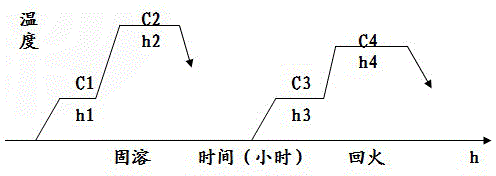Heat treatment method for high-strength high-hardness marine-corrosion-resistant non-magnetic steel
A heat treatment method and non-magnetic steel technology, applied in the field of alloy material preparation, can solve the problems of insufficient corrosion resistance, insufficient strength and wear resistance, affecting the service life of the drum, etc.
- Summary
- Abstract
- Description
- Claims
- Application Information
AI Technical Summary
Problems solved by technology
Method used
Image
Examples
Embodiment 1
[0080] 1. Processing of anti-corrosion and anti-magnetic steel: Add steel scrap and pig iron into the melting furnace to heat up and melt. The melting furnace should be an intermediate frequency induction furnace. The melting temperature is generally around 1450°C-1550°C. Add nickel plate, ferromanganese, ferrochromium, ferromolybdenum, ferrovanadium and ferroniobium in sequence, and the diameter of the material block is preferably 50-80mm. The mass percentages of the above chemical components are controlled as follows: C: 0.30%, Si: 0.80%, Mn: 0.85%, Cr: 18.00%, Ni: 12.00%, Mo: 2.00%, V: 0.50%, Nb: 0.15%. After melting, when the furnace temperature reaches 1550-1580°C, deoxidation, dehydrogenation and denitrification are required. The deoxidizer is made of aluminum wire, Si-Ca alloy or SiC, and the deoxidizer is pressed into the depth of the furnace, and then ferrotitanium ( The diameter is preferably 3-5mm), Ti: 0.15%. At this time, the metal liquid surface is covered with a...
Embodiment 2
[0085] 1. Processing of anti-corrosion and anti-magnetic steel: Add steel scrap and pig iron into the melting furnace to heat up and melt. The melting furnace should be an intermediate frequency induction furnace. The melting temperature is generally around 1450°C-1550°C. Add nickel plate, ferromanganese, ferrochromium, ferromolybdenum, ferrovanadium and ferroniobium in sequence, and the diameter of the material block is preferably 50-80mm. The mass percentages of the above chemical components are controlled as follows: C: 0.28%, Si: 0.83%, Mn: 1.20%, Cr: 18.8%, Ni: 11.5%, Mo: 2.25%, V: 0.53%, Nb: 0.13%. After melting, when the furnace temperature reaches 1550-1580°C, deoxidation, dehydrogenation and denitrification are required. The deoxidizer is made of aluminum wire, Si-Ca alloy or SiC, and the deoxidizer is pressed into the depth of the furnace, and then ferrotitanium ( The diameter is preferably 3-5mm) Ti: 0.14%, the metal liquid surface is covered with a covering agent a...
Embodiment 3
[0090] 1. Processing of anti-corrosion and anti-magnetic steel: Add steel scrap and pig iron into the melting furnace to heat up and melt. The melting furnace should be an intermediate frequency induction furnace. The melting temperature is generally around 1450°C-1550°C. Add nickel plate, ferromanganese, ferrochromium, ferromolybdenum, ferrovanadium and ferroniobium in sequence, and the diameter of the material block is preferably 50-80mm. The mass percentages of the above chemical components are controlled as follows: C: 0.34%, Si: 0.90%, Mn: 1.45%, Cr: 17.4%, Ni: 12.8%, Mo: 2.45%, V: 0.48%, Nb: 0.12%. After melting, when the furnace temperature reaches 1550-1580°C, deoxidation, dehydrogenation, and denitrification are required. The deoxidizer is made of aluminum wire, Si-Ca alloy or SiC, and the deoxidizer is pressed into the depth of the furnace, and then ferrotitanium ( The diameter is preferably 3-5mm) Ti: 0.17%, the metal liquid surface is covered tightly with a coverin...
PUM
 Login to View More
Login to View More Abstract
Description
Claims
Application Information
 Login to View More
Login to View More - R&D
- Intellectual Property
- Life Sciences
- Materials
- Tech Scout
- Unparalleled Data Quality
- Higher Quality Content
- 60% Fewer Hallucinations
Browse by: Latest US Patents, China's latest patents, Technical Efficacy Thesaurus, Application Domain, Technology Topic, Popular Technical Reports.
© 2025 PatSnap. All rights reserved.Legal|Privacy policy|Modern Slavery Act Transparency Statement|Sitemap|About US| Contact US: help@patsnap.com

